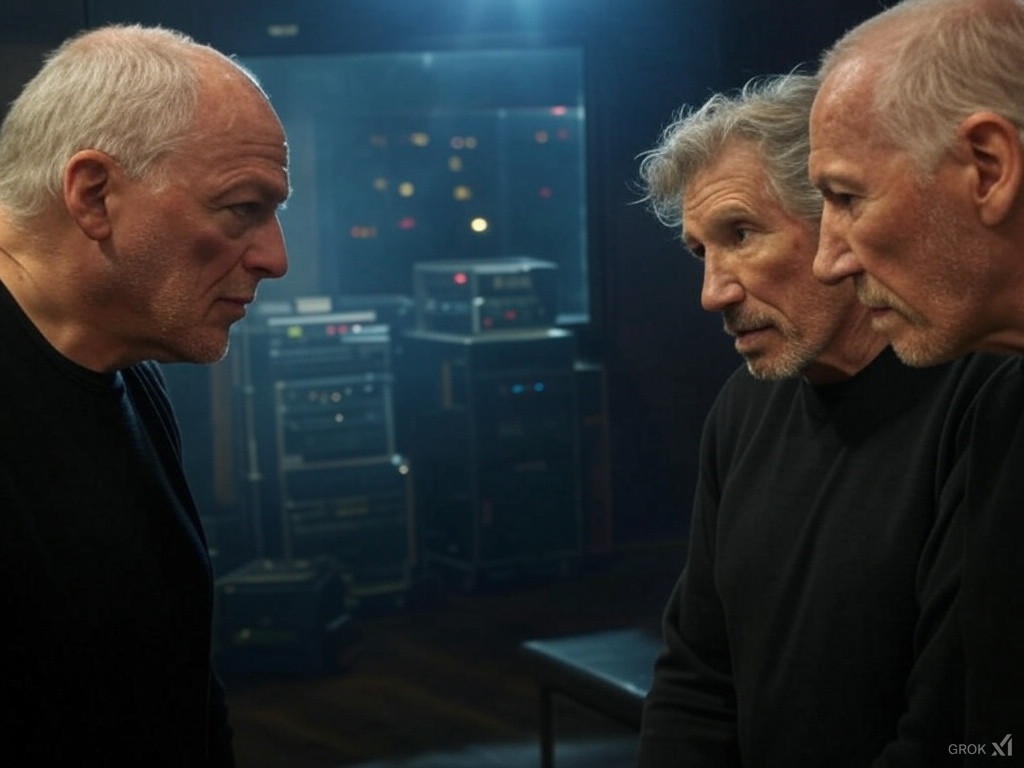 Los Angeles, late 1979. A dimly lit control room in Producers Workshop.
Los Angeles, late 1979. A dimly lit control room in Producers Workshop.
Roger Waters and David Gilmour are locked in yet another shouting match—this time over Comfortably Numb.
“The verses need to be dry, stripped down. No big, emotional swill!” Waters insists, voice sharp, eyes burning.
Gilmour scoffs. “You’re killing the song! The chorus needs to soar, Roger! It’s the climax of the whole bloody thing!”
Their words ricochet off the walls, their frustrations festering. This isn’t just a disagreement—it’s a battle of wills, the latest in a long war that’s been raging since The Wall began taking shape.
In the middle of it all, Bob Ezrin rubs his temples, trying to keep his patience. He’s seen this before—two brilliant artists colliding, their egos clashing with their genius. But this time, he’s had enough.
Without a word, he walks over to the door. Click. The lock turns.
“Alright,” Ezrin says, voice calm, measured. “Nobody leaves until we get this right.”
A tense silence falls over the room. The two Pink Floyd leaders stare at him, dumbfounded.
“What the hell are you doing?” Waters snaps.
Ezrin meets his glare, unflinching. “You’re both wrong. And you’re both right. We’re going to do it my way.”
The room stays still. No one moves. No one speaks.
But Ezrin is about to make his stand.
No discussion of The Wall can start anywhere other than Roger Waters. This was his album, his story, his rage and disillusionment poured into music. By the late ‘70s, he was growing increasingly detached—from audiences, from bandmates, from the very notion of rock stardom itself. The seeds of The Wall were planted in 1977, when, during a Pink Floyd concert, he became so uncomfortable with the crowd’s behavior that he fantasized about building a literal wall between himself and them.
That moment of alienation sparked something in Waters. He envisioned an album that would explore themes of psychological isolation, personal trauma, and the dangerous allure of authoritarianism. Drawing from his own experiences—including the death of his father in World War II, a strained education system, and the pressures of fame—Waters crafted a narrative that was part autobiography, part dystopian nightmare.
With The Wall, he wasn’t just writing an album—he was building an entire world.
Waters may have had the vision, but the scale of it was overwhelming. Enter Bob Ezrin.
Ezrin wasn’t just there to produce—he was there to refine, to shape, to ensure that The Wall wasn’t just an indulgent, sprawling mess. When Waters presented his ideas, Ezrin made a bold suggestion:
“We need a script. Not just a track list—a real, structured narrative.”
At first, Waters resisted. He was fiercely protective of his work, reluctant to let anyone else shape its form. But Ezrin knew the power of storytelling, and he fought for the structure that would keep The Wall from collapsing under its own weight. He insisted on treating the album like a Broadway show, mapping out scenes, defining character arcs, and ensuring that each song served a larger narrative purpose.
It was Ezrin who brought in the school choir for Another Brick in the Wall, Part 2, convincing Waters that it would add a layer of eerie, detached rebellion. It was Ezrin who fought for pacing, making sure the album ebbed and flowed with the right tension. And it was Ezrin who, when Gilmour and Waters clashed over Comfortably Numb, made the call that would turn it into a masterpiece.
If The Wall was Waters’ story, then Gilmour provided the voice that made it sing. The creative tension between them was both the album’s greatest strength and its biggest obstacle.
Waters brought the raw, emotional intensity—lyrics drenched in paranoia and discomfort. Gilmour brought the soaring, melodic beauty—those ethereal guitar solos that felt like moments of breaking through despair. Together, they created some of the most iconic music in rock history.
But that tension was volatile.
And in Comfortably Numb, it came to a head.
Gilmour’s original demo was melancholic yet lush, its chord progression haunting and hypnotic. Waters, ever the minimalist, wanted it stripped down, stark, almost lifeless. Gilmour wanted it grand, cinematic.
Ezrin, watching two geniuses at odds, made his choice.
The tension in the studio is unbearable. Waters and Gilmour are still glaring at each other, neither willing to give an inch.
Ezrin exhales. “Roger, the verses stay your way—dry, detached, almost lifeless. That fits the story. But David’s chorus? It stays massive. Orchestral. Emotional.”
Silence.
Then, Waters sighs, running a hand through his hair. He relents.
Gilmour nods, arms crossed, still fuming, but willing to trust the man who had already shaped so much of The Wall.
Ezrin unlocks the door. “Alright,” he says. “Now let’s make history.”
And they do.
The final version of Comfortably Numb becomes one of the defining moments of The Wall, the contrast between the bleak verses and the soaring chorus cementing its place in rock history.
By the time The Wall was completed, Roger Waters had asserted near-total dominance over Pink Floyd. Richard Wright had been fired during recording, Nick Mason was largely uninvolved, and Gilmour and Waters’ relationship was beyond repair. The album’s sheer ambition had pushed everyone to the breaking point.
But The Wall wasn’t just finished—it became a cultural landmark. It went on to sell over 30 million copies worldwide, define an era of rock music, and inspire one of the most ambitious tours in history.
Today, The Wall is remembered as Waters’ magnum opus—a deeply personal, deeply political statement wrapped in some of the most haunting and beautiful music ever recorded. But its greatness also lies in the delicate balance of vision, musicianship, and production.
Waters built The Wall. Ezrin made it stand. Gilmour gave it its soul.
And for a brief, tense moment in a locked studio, they all worked together to make history.